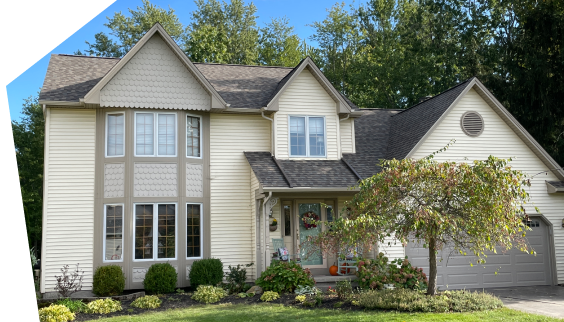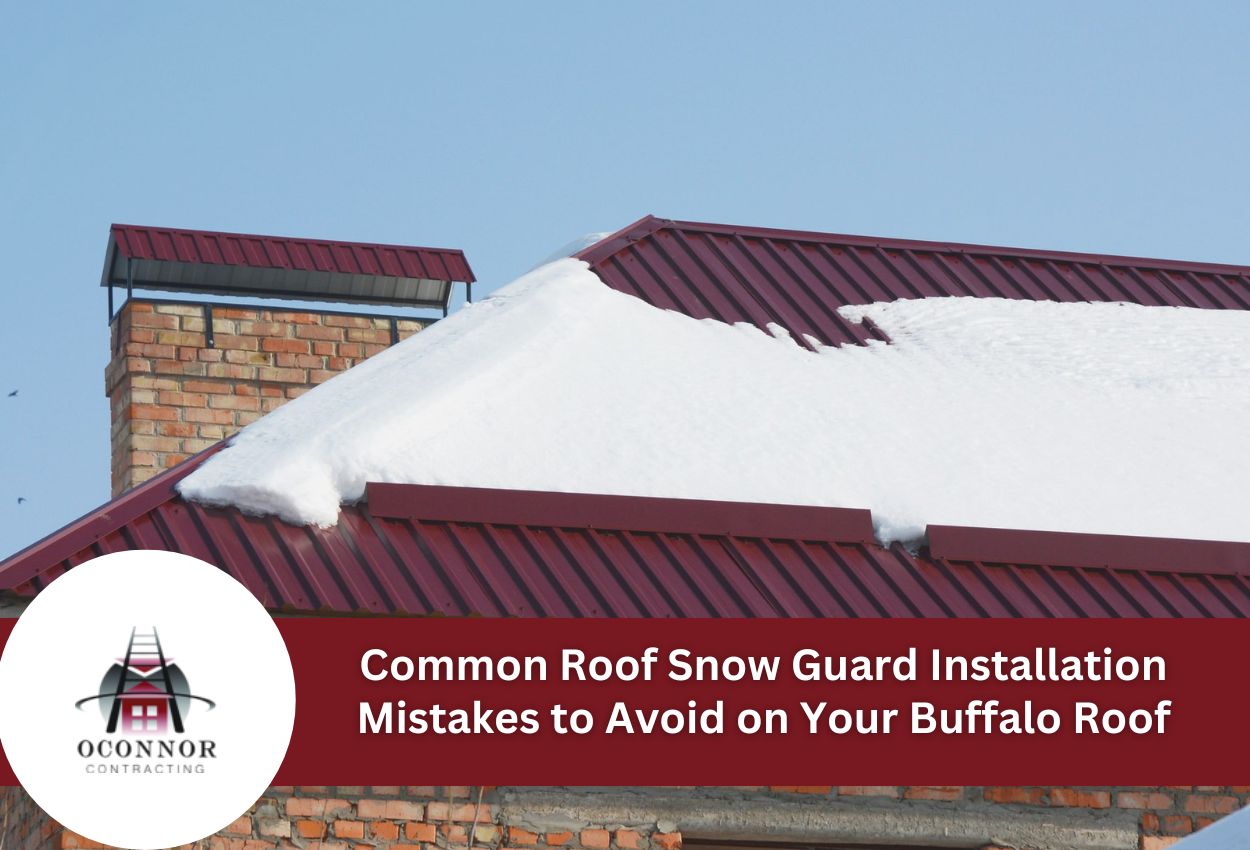Winter can be a tough time of year for much of Western New York. In preparation, taking time during the summer to install snow guards is one of the best ways to protect your home when the seasons change.
Snow guards serve as crucial defense mechanisms against dangerous snow avalanches that can damage property and injure people below. However, installing them incorrectly can equally lead to expensive repairs and compromised safety.
Snow guards are designed to hold snow and ice in place, allowing it to gradually melt rather than fall in sudden, dangerous slides. During Buffalo’s harsh winter, where annual snowfall regularly exceeds 90 inches, these devices are not only useful but necessary for responsible home maintenance. They help prevent ice dams, protect gutters, and maintain roof integrity throughout the demanding winter.
Many Buffalo homeowners attempt DIY snow guard installations to save money, only to discover that placing them improperly creates more problems than solutions. From incorrect spacing to using inadequate fasteners, these mistakes can compromise your entire roofing system. Metal roofs particularly require specialized snow retention systems that account for expansion, contraction, and the smooth surface that allows snow to slide more readily.
Understanding proper roof snow guard placement techniques and avoiding common installation errors will help protect your investment while ensuring safety for family members and visitors. The following information highlights the most frequent snow guard installation mistakes and provides practical winter roof damage prevention tips for Buffalo homes.
Incorrect Placement: The #1 Snow Guard Installation Error
The most common mistake Buffalo homeowners make when installing snow guards is incorrect placement. Many DIYers position these devices randomly across the roofing surface or arrange them based on aesthetic preferences rather than functional requirements. This approach fundamentally misunderstands how snow accumulates and shifts on a roof.
The weight of the snow doesn’t necessarily distribute evenly across your roofing surface. As snow accumulates and begins to warm, it creates a slippery layer along the surface of the roofing material. Without properly positioned snow guards, this entire mass can slide off at once, especially if you have a metal roof. The science behind effective snow retention requires understanding that snow guards must be placed to manage the gravitational forces at work on your specific roof pitch.
For most Buffalo homes, proper placement includes installing the first row of snow guards 12 to 24 inches from the edge of the roof, not directly at the edge as many assume. The positioning of the first row is critical in order to prevent the initial movement of snow that triggers larger avalanches. Subsequent rows should follow specific patterns based on the type of roofing material. For instance, slate roofs typically require staggered patterns, while metal roofs need evenly spaced rows with calculations based on roof pitch and snow load factors.
Different roofing materials demand different approaches. Metal roofs, in particular, require more frequent snow guards placed on the roof due to their smooth surface. Asphalt shingle roofs need proper attachment methods that won’t compromise waterproofing. Professional snow guard installation ensures these requirements are met based on Buffalo’s specific winter conditions and your home’s unique design.
Using Incompatible Snow Guards for Your Roofing Material
Not all snow guards are created equal, and using incompatible types for your specific roofing material is a critical mistake many Buffalo homeowners make. Different roofing systems require specialized snow retention solutions designed for their unique characteristics and installation methods.
Pad-style snow guards work well with asphalt shingle and slate tile roofs throughout Buffalo neighborhoods, attaching directly to the roof’s surface with adhesives or mechanical fasteners. Rail-style systems, featuring one or more horizontal tubes, are ideal for metal roofs as they can handle larger amounts of snow typical in our region.
Installing the wrong type of snow guard can create serious problems. For example, attaching pad-style guards to metal roofs using improper fasteners can puncture the metal panels, creating points that allow moisture to enter your home.
Before selecting snow guards for your Buffalo home, consult with roofing professionals who understand local snow load requirements and can recommend proper retention systems that maintain your roof’s weather resistance through our challenging winters.
Attachment Method Failures: When Good Snow Guards Fall Off
Even properly positioned snow guards can fail dramatically if they’re not securely attached to your roof. In Buffalo’s harsh winter, the difference between adhesive and mechanical fastening methods becomes critically important when several feet of lake-effect snow puts pressure on your snow retention system.
Adhesive-mounted snow guards often fail mid-winter when temperatures fluctuate between freezing nights and occasional warmer days. These temperature swings weaken the bond between the adhesive and the roofing surface, causing guards to detach precisely when heavy snow loads demand maximum performance. Mechanical fasteners generally provide superior holding power but must be installed correctly to prevent roof leaks.
For metal roofs popular in snow-heavy Buffalo neighborhoods, specialized clamp-on snow guards that attach to standing seam panels offer the best solution. These fastening systems work with the natural expansion and contraction of metal panels without puncturing the roofing surface. Color-matched options blend seamlessly with your roof while maintaining structural integrity.
When installing snow guards on asphalt shingle roofs, proper sealing around fasteners is essential. Many DIY installations skip this critical step, creating entry points for moisture that lead to rot and interior damage. Professional installation includes weatherproofing each hole in the roof with appropriate sealants rated for Buffalo’s extreme weather conditions.
Underestimating Required Quantity and Load Capacity
One of the most expensive mistakes Buffalo homeowners make when installing snow guards is underestimating how many they actually need. Many property owners don’t install enough snow guards, creating insufficient retention capacity for our region’s substantial lake effect snow accumulation. This miscalculation can lead to catastrophic snow slides that damage gutters, landscaping, and anything below the roofline.
For Buffalo homes, proper snow guard calculations must account for roof pitch, slope length, and the amount of snow that our region typically gets. As a general guideline, steeper roofs require more snow guards per square foot than gentler slopes. A roof with a 12:12 pitch (45 degrees) may need twice as many snow guards as a 4:12 pitch of the same size. Additionally, steeper roof slopes require more rows of guards to distribute the weight of accumulated snow effectively.
Warning signs of an undersized snow retention system include partial snow slides occurring between guards, visible bending of snow guard components, and creeping snow movement after heavy storms. In Western New York, where single lake effect events can dump more than 24 inches of snow, undersized systems often fail catastrophically during the first major snowfall, when they’re needed most.
Professional snow guard installation includes load capacity calculations specific to the dimensions of your roof and Buffalo’s snow load requirements. This engineering approach ensures your system can handle our worst winter conditions without failure, protecting your property throughout our challenging winter.
Why DIY Installation Is A Bad Idea
Attempting to install roof snow guards without specialized tools is a common mistake that Buffalo homeowners make while preparing for the winter. Professional installers use specific equipment like torque wrenches, seam clamps, and proper drill bits designed specifically for different roofing materials. Without these tools, DIY installations often result in loose attachments, improper sealing, and potential roof damage that creates leaks when spring thaws arrive.
Metal roofs require particular attention during snow guard installation. Without a proper seam roller or clamp, homeowners risk damaging the protective coating on metal panels, which leads to early corrosion due to Buffalo’s salt-laden winter environment. Slate and tile roofs demand specialized bits and careful technique to prevent cracking these expensive materials during the fastening process.
Proper technique extends beyond just attaching the guards. Professional installation includes verifying that each guard aligns correctly with the roof’s panels and seams. This alignment ensures even distribution of snow loads across the entire system. Weather-sealing around attachment points requires meticulous application to prevent moisture infiltration, which is especially important given Buffalo’s freeze-thaw cycles that can expand tiny gaps into significant leaks.
Most DIY installations also overlook the critical step of calculating proper torque specifications. Over-tightened fasteners can warp metal panels or crush roofing materials, while under-tightened connections may fail under heavy snow loads. With Buffalo regularly receiving significant snowfall events, proper installation technique becomes essential for system reliability throughout our challenging winter season.
Ignoring Manufacturer Specifications and Local Building Codes
Overlooking manufacturer specifications when installing snow guards is a critical mistake that may have serious consequences for Buffalo homeowners. Each snow guard system is designed with specific installation parameters that ensure the right performance under heavy snow loads. When these guidelines are ignored, the entire snow retention system can fail during crucial winter storms, leading to dangerous snow slides and property damage.
Manufacturer warranties typically become void when installation instructions aren’t followed precisely. This means that if you installed snow guards improperly yourself, and they fail during a Buffalo blizzard, you’ll be responsible for all the resulting damages with no help from the manufacturer.
Equally important are Buffalo’s local building codes regarding snow retention systems. Our region’s specific requirements reflect decades of experience with lake effect snow and the unique challenges it presents to roofing systems. These codes establish minimum standards for snow guard placement, quantity, and attachment methods based on our area’s substantial snow loads.
Working with local roofing professionals ensures your snow guard installation meets both the manufacturer’s specifications and Buffalo building codes. These experts understand how to integrate proper roof snow guard placement techniques with regional requirements, providing documentation that your system meets all relevant standards. This approach not only protects your property, but it also maintains insurance coverage by ensuring all winter roof damage prevention measures comply with local regulations.
Avoid Common Snow Guard Installation Mistakes with the Team at OConnor Contracting
When it comes to installing snow guards on your roof, ensuring proper technique and adhering to local Buffalo requirements is crucial. Don’t let common mistakes compromise the safety and integrity of your roof. If damage does occur, reach out to our team at OConnor Contracting, since we specialize in professional roof repair and can help you find the right snow guards for your needs.
Give us a call today at (716) 600-7663, and take advantage of the summer weather to prepare for what’s to come!


